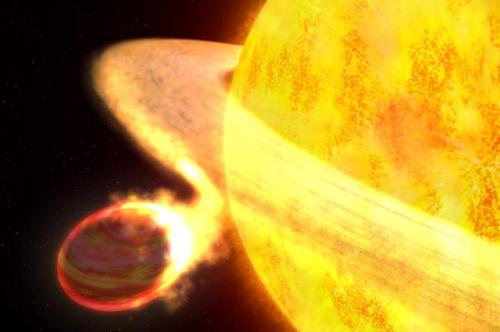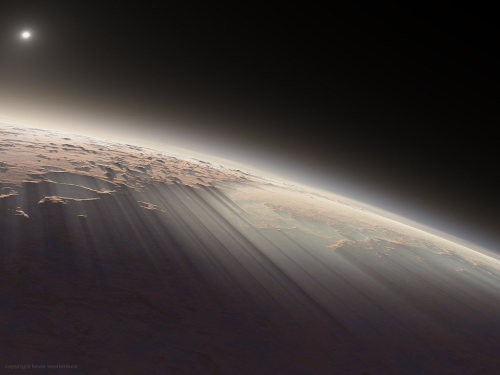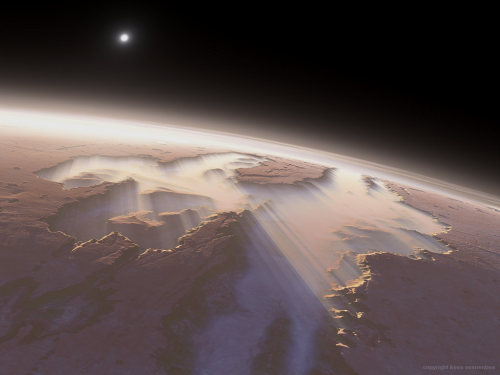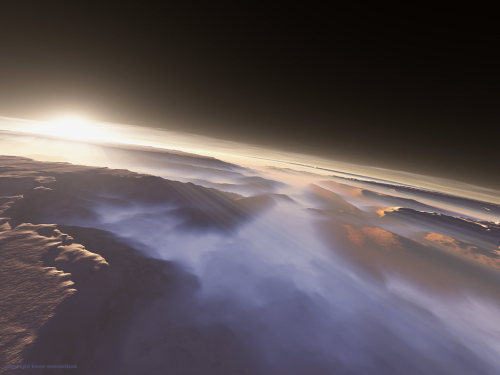“But Then She Was A Dancer. Dancers Are Tough.” -“The Wizard’s Dilemma,” Diane Duane, (x) (x)


“But then she was a dancer. Dancers are tough.” -“The Wizard’s Dilemma,” Diane Duane, (x) (x) Dedicated to Betty Callahan.
More Posts from Outofambit and Others

Most Amazing Exoplanets
The term ‘exoplanet’ applies to any planet outside of our solar system. At last count, we have identified 3,538.
Out of the thousands of planets we know about, some of them are incredibly bizarre compared to what we are used to seeing in our own solar system. Here are some exoplanets with very unique characteristics:
Kepler-78b
The most astounding fact about Kepler-78b is that it shouldn’t even exist, according to our current knowledge of planetary formation. It is extremely close to its star at only 550,000 miles (900,000 kilometers). As a comparison, Mercury only gets within 28.5 million miles (45.9 million kilometers) of the sun in the nearest point of orbit. With that proximity, it isn’t clear how the planet could have formed as the star was much larger when the planet formed. With its current distance, that would mean it formed inside the star, which is impossible as far as we know.
The planet itself is only slightly larger than Earth, though surface conditions are markedly different. The temperature on the surface is estimated to be 4300° F (2400° C), which is nearly nine times as hot as the temperature on Venus. Unfortunately for Kepler-78b, it is likely that the star’s gravitational pull will gradually bring the star closer and totally consume it in the next 3 billion years.
WASP-12b
While Kepler-78b still has about 3 billion more years before getting consumed by its star, the process is well underway for WASP-12b. This exoplanet is actively getting pulled apart by its parent star, much to the delight of astronomers who can watch the process unfold. So much material has been pulled away from the planet, it has been pulled into an oblong football shape. Astronomers have estimated that WASP-12b has about 10 million more years until it is completely pulled apart by the star.
The planet is described as a “hot Jupiter” as it is a gas planet that is about 40 percent larger than Jupiter. It is currently so close to its star that it only takes 1.1 Earth days for the planet to complete a full orbit. The star, WASP-12, is G-type main sequence star, just like our own sun. It is located about 800 lightyears away in the Auriga constellation.
TrES-2b
TrES-2b has been dubbed the “dark planet” because it does not reflect light. If we were able to view it directly, it would likely just look like a coal-black ball of gas. At 1800°F (1000°C) the planet is way too hot for clouds, which would help reflect the star’s light. The red tinges are areas of superheated gas. Other darker planets only reflect about 10% of the star’s light, but TrES-2b only reflects about 1%, making it the darkest planet ever discovered.
Why is TrES-2b so dark? Scientists aren’t quite sure. Right now, the best guess is that the majority of the planet’s composition is something like sodium or potassium which absorbs light. This dark world is located about 750 lightyears away in the Draco constellation.
HD 189773b
HD 189773b is pretty exciting. It is relatively close, at only 63 lightyears away. It is also the first planet to have its color determined and it turned out to be a pretty blue planet, just like Earth. Unlike Earth, however, HD 189773b is a gas giant with a temperature that reaches a sweltering 1800°F (1000°C). The weather gets more extreme, because intense pressure and temperature turns silicate particles in the atmosphere into glass, which then rains down. As if that doesn’t sound dangerous enough, the winds have been estimated to gust at 4,000 mph (7,000 km/h) which really whips those glass particles around.
55 Cancri e
55 Cancri e is twice the size of Earth but is nearly 8 times more massive and twice as dense. Last fall, researchers deduced that the mass of the planet was largely carbon. Due to the pressure and surface temperature of 4892°F (2700°C) it very well could have formed diamond. It is so close to its parent star it takes a mere 18 hours for the planet to complete a full orbit.
55 Cancri e is only about 40 light-years away from us in the Cancer constellation. The parent star is much more carbon than our own sun, so it might be too surprising that planet e is also carbon-rich. From there, it isn’t much of a stretch to assume that the other four known planets in the system would also have a high carbon content.
Because of these extreme conditions, astronomers don’t believe that 55 Cancri e has an atmosphere, making it a poor candidate for the possibility for life. However, it is close enough for astronomers to use it to test hypotheses about planetary formation.
PSR B1620-26b
Nicknamed “Methuselah,” PSR B1620-26b is the oldest known exoplanet. The planetary system formed approximately 12.7 billion years ago, when the Milky Way galaxy was in its infancy. It is located in the Scorpius constellation about 12,400 lightyears away.
Methuselah orbits binary stars and goes around them in a circumbinary orbit. As if Methuselah’s age isn’t interesting enough, the fact that it orbits two mismatched dead stars is quite unusual. One of the stars is a pulsar and the other is a white dwarf. Since Methuselah is found in a dense star cluster, astronomers initially thought it could be a star as well, and would be considered a brown dwarf. Measurements from the Hubble would confirm that Methuselah is a planet, and it remains the oldest one we’ve ever discovered.
TrES-4
Located 1,400 lightyears away in the Hercules constellation, TrES-4 is the largest exoplanet we have discovered so far. Though it is over 1.7 times the size of Jupiter, it has an extremely low density and is categorized as a “puffy” planet. The planet’s density is about the same as cork, which came as quite a shock. Astronomers attribute this to extreme heat of 2,300° F (1,260° C) due to is proximity to the star. At only 4.5 million miles (7.2 million kilometers) away from its sun, TrES-4 is able to complete an orbit in three Earth days.
Gliese 436 b
30 lightyears away in the constellation Leo, Gliese 436 b is a planet that is about as massive as Neptune. The planet also happens to be covered in burning ice - though the ice isn’t anything like what we’re used to. The extreme pressure of the planet forces the water to stay in solid form, even though the temperature exceeds 570° F (300° C). The outer layer of the solid water is superheated and comes off as vapor. Water has over 10 solid states, not including common ice.
In its present position, the water would not have been able to condense down into a solid, indicating that it migrated toward its sun after it formed.

Terraformation of Mars: A New Look
We look at Mars now as a forgotten Red Planet that almost seems barren and life-less judging from our available images and study of it. But study shows Mars was once as ecologically prosperous as our own Earth. But what happened to all of its waters? Better yet why is it so dry and lacking any plants? Once the abundance of oxygen left and the waters froze over or dried off the planet became what it is today. But what if we can in a way reactivate’ Mars? Welcome to Mars, Terraformed’.
About Terraforming
Transforming Mars will be a long and complicated process. But this is exactly the type of subject that interests space researchers like Christopher McKay of NASA Ames Research Center. First, greenhouse gases, like chlorofluorocarbons that contribute to the growing ozone layer on Earth, will be released into the atmosphere. This traps the heat from the Sun and raises the surface temperature by an average of 4 degrees Celsius. In order to achieve this, factories would manufacture chlorofluorocarbons derived from the air and soil. A single factory would require the power equivalent of a large nuclear power plant.
The increasing temperature would vaporize some of the carbon dioxide in the south polar cap. Introducing carbon dioxide into the atmosphere would produce additional warming, melting more of the polar cap until it has been vaporized completely. This would produce an average temperature rise of 70 degrees Celsius.
With the temperature this high, ice will start melting, providing the water needed to sustain life. This water would raise the atmospheric pressure to the equivalent of some mountaintops. While this would be a survivable level, it may still require the use of an oxygen mask. The next step, which may take up to several centuries, would be to plant trees that thrive on carbon dioxide and produce oxygen.

NASA: Terraforming Mars
Terraforming is the process of transforming a hostile environment into one suitable for human life. Being that Mars is the most Earth-like planet, it is the best candidate for terraforming. Once just the subject of science fiction novels, it is now becoming a viable research area. The famed astronomer and Pulitzer prize winner, Carl Sagan, says that there is enormous promise in the search for ancient life on Mars. If life was once sustainable on Mars, it is important to know what caused Mars to evolve into the cold and lifeless planet it is today. With this knowledge, we can terraform Mars by reversing the process.
NASA scientists believe that it is technologically possible at the present time to create considerable global climate changes, allowing humans to live on Mars. But this will not be by any means an easy task. Raising the atmospheric pressure and surface temperature alone could be achieved in a few decades.
This research has strong environmental implications for Earth. What researchers are trying to do involves global warming, a sort of greenhouse effect on the cold planet Mars. Scientists may be able to test their hypotheses about global warming in their attempts to elevate Mars’ surface temperature. Likewise, once theories, they may be applied to our own planet in an attempt to reverse environmental damage done by pollution and deforestation.

Success! India’s First Mars Probe Is In Orbit And Working
“India has managed to do what few other nations have accomplished: putting a satellite into orbit around another planet — and it did so a lot cheaper than the competition.
The $70 million Mangalyaan, or “Mars craft” in Hindi, began circling Mars after a 24-minute engine burn to slow it down enough to be captured by the Red Planet’s gravity.”
Read more from NPR.
There was a point where, whenever I ran into my stalker...
…I wanted to greet her with “Fairest and fallen, greeting and defiance, now and always.”
Not because I thought she was literally the Lone Power. But because she was clearly one of those people the Lone Power was acting through and loving it. And because dealing with her seemed to be part of my Ordeal.
And honestly because remembering that there are malevolent forces in the universe that use people like her to hurt people (and that she would willingly hand herself over to such forces if she believed in them, she was that kind of person), and that those malevolent forces of the universe can be named, greeted, and resisted, even resisted politely, was very important.
If you ever hear me say anything starting with “Fairest and fallen…” you know I’m serious. I may be wry, I may be half-joking, but some part of me is deadly serious if you hear those words come out of my mouth. It means “I know you. I know what I’m looking at. I know where your evil comes from, even if you don’t. And I won’t put up with it, and I won’t stand by and let this happen.”
The Young Wizards books are among a type of books I’ve read that hide deep and meaningful truths about the universe in the guise of ordinary children’s books. That’s my favorite type of book, ever.
I once read someone on dduane’s tumblr saying that when she was a kid, she would repeat the Wizard’s Oath over and over again, hoping it would make her a wizard.
I wrote to dduane telling her that I hadn’t read them as a kid. But when I grew up, I found that the Wizard’s Oath had already somehow become etched onto my heart, and it only took reading the words to remember how it happened. She said she gets that response from adults now and again.
There are many versions of the Wizard’s Oath, and some fans (including me) have made our own recensions. Each person gets the version they need. But here’s the one from the first book:
In Life’s name and for Life’s sake, I say that I will use the Art for nothing but the service of that Life. I will guard growth and ease pain. I will fight to preserve what grows and lives well in its own way; and I will change no object or creature unless its growth and life, or that of the system of which it is part, are threatened. To these ends, in the practice of my Art, I will put aside fear for courage, and death for life, when it is right to do so — till Universe’s end.
Here’s a version written for a dinosaur who had been living underground in a dystopian city:
“The Fire is at the heart, and the Fire is the heart; for its sake, all fires whatever are sacred to me. I shall kindle them small and safe where there are none, for the wayfinding of those who come after: I will breathe on those fires about to die in dark places, and in passing, feed those that burn without harm to any; the fire that burns and warms those who gather about it, in no wise shall I meddle with it save that it seems about to consume its cofocals, or to die. To these ends, as the Kindling requireth, I shall ever thrust my claw into the flames to shift the darkening ember or feed the failing coal, looking always toward that inmost Hearth from which all flames rise together, and all fires burn undevouring, in and of That Which first set light to the world, and burns in it ever more…”
And my personal recension:
In the soil, we are all growing, together. I will moisten the roots of those who need water. I will never allow the soil to dry out. I will make room for seeds to grow into plants. I will allow the soil to consume the parts of me that are no longer needed, and I will reach towards the sun. I will not touch leaves that may die at my touch, unless it is necessary to prevent some greater harm. I will love sorrel and tree, fungus and slug, alike. I will live inside of love, and let love guide me, to the best of my ability. I will look always to the place where all of our roots reach down as one.
Over 2 light years across and over 2000 light years away from Earth: The Ghost Nebula (Hubble)

Okay, so I’ve just started Games Wizards Play book 10 in the Young Wizards series, which means it’s time for some thoughts on my FAAAAAAAV YA SERIES OF ALL TIME. (No offense HP, no offense)
ROSHAUN MY CHILD MY SON COME BACK TO ME!!! COME BACK TO ME BABY! IT HAS BEEN ONE WHOLE BOOK AND HE’S NOT BACK YET I AM NOT OKAY! I AM NOT ALRIGHT! THE MADNESS MUST END! PLEASE GOD MAKE IT STOP JUST BRING BACK MY BABY PLEASE OH PLEASE OH PLEASE! WE LOST PONCH I CAN’T HAVE THIS TOO I CAN’T TAKE THIS OH GODDDDDDD *INCOHERENT SOBBING*
And I am done. This is basically my internal stream of consciousness all through A Wizard of Mars tbh. I have basically been a blithering, sobbing, screaming wreck since Wizards at War. Life’s been hard. And since my house burned down, I don’t even have my ENTIRE COMPLETE collection to reference : |
Some further reviews on the Young Wizards series:
So You Want To Be a Wizard…
You will cry because of a car
Deep Wizardry
You will cry because of a shark
High Wizardry
You will cry because of a space turtle
A Wizard Abroad
You will cry because of Ireland
A Wizard’s Dilemma
You will cry because of a parrot. Also cancer.
A Wizard Alone
You will cry because of autism
Wizard’s Holiday
You will cry because of a barren hellscape
Wizards at War
You will cry because of OH GOD NOT THE DOG PLEASE NOT THE DOG OH GOD NO
A Wizard of Mars
You will cry because you are no longer capable of feeling anything because the last book emotionally broke you.
Great series. 10/10. Would recommend to all your friends and loved ones and then you can all cry together.


Kepler Mission Analysis Shows Reduced Number of Earth-Sized Planets in Field of View
A large number of worlds found by NASA’s Kepler alien planet-hunting space telescope are probably significantly larger than scientists previously estimated, a new study suggests. Using a galaxy similar to our own Milky Way, the image above shows the scale of the distances for the sample of stars with planet candidates described in a new study by scientists using the Kitt Peak National Observatory Mayall 4-meter telescope . The circled dot represents the position of the sun in the Milky Way, and the stippled cone shows how far away the new candidate stars are (2800-7000 light years), compared to the size of our galaxy.
The Kepler Space Telescope has spotted more than 2,700 potential exoplanets since its launch in 2009, and scientists using the Kitt Peak National Observatory categorized the home stars of many of those planet candidates for the past three years. In particular, the researchers made detailed follow-up observations of 300 of the stars Kepler found likely to be harboring exoplanets.
The Kepler satellite, in orbit around the sun, stares at a region of the northern hemisphere sky sandwiched between the bright stars Vega and Deneb. Attached to the telescope is the largest imaging camera ever flown into space—16 million pixels—the only instrument on the telescope and the one used to monitor all the stars in its search for planets. Planets are detected if they pass in front of their parent sun, causing a very slight dip in the star’s brightness. When this dip repeats periodically, it reveals the presence of a possible planet, the length of the planet’s “year”, and other information.
One of the main findings of this initial work is that our observations indicate that most of the stars we observed are slightly larger than previously thought and one quarter of them are at least 35 percent larger,” astronomer and leader of the study Mark Everett said in a statement. “Therefore, any planets orbiting these stars must be larger and hotter as well. By implication, these new results reduce the number of candidate Earth-size planet analogues detected by Kepler.”
Read



The Journey to Mars Begins Tomorrow
NASA is preparing for the first test flight of the Orion crew vehicle set for an unmanned launch on Dec. 4 at 7:05 a.m. EST from Cape Canaveral, Florida.
The Orion spacecraft is designed to eventually take astronauts beyond low-Earth orbit to destinations never explored by humans. It will serve as the exploration vehicle that will carry the crew to distant planetary bodies, provide emergency abort capability, sustain the crew during space travel, and provide safe reentry from deep space.
This mission is the first of three trial runs that the Orion mission must overcome before NASA deems it safe enough for human space travel.
The next test flights in 2018 and 2021 will use NASA’s Space Launch System rocket (SLS), which is currently in development. When it’s finished, SLS will be the most powerful rocket ever built, boasting even more thrust than the Saturn V booster that blasted astronauts toward the moon in the Apollo era.
The spacecraft will launch atop a Delta IV Heavy, a rocket built and operated by United Launch Alliance. While this launch vehicle will allow Orion to reach an altitude high enough to meet the objectives for this test, a much larger, human-rated rocket will be needed for the vast distances of future exploration missions.
Exploration Flight Test-1, will mark the farthest distance traveled by a human spaceflight vehicle since 1972 made by Apollo 17.
During its grueling four-and-half-hour test mission, NASA’s Orion space capsule must shoot 3,600 miles away from Earth (15 times higher than the International Space Station!), orbit the planet twice, and brave a thick belt of cosmic radiation.
Upon re-entry it must deploy 11 parachutes to slow down from 20,000 miles per hour to 20 mph, while withstanding 4,000-degree Fahrenheit temperatures before plunging into the Pacific Ocean.
Check out these incredible photos from the development and testing of the spacecraft.
Countdown, launch and mission coverage will begin at 4:30 a.m. on NASA TV which is available on air and streaming at nasa.gov/nasatv

It just makes sense
-
 independence1776 reblogged this · 9 years ago
independence1776 reblogged this · 9 years ago -
 gandalfsmom liked this · 9 years ago
gandalfsmom liked this · 9 years ago -
 savageanddangerous liked this · 10 years ago
savageanddangerous liked this · 10 years ago -
 figgyforprez liked this · 10 years ago
figgyforprez liked this · 10 years ago -
 peoples-republic-of-antarctica liked this · 10 years ago
peoples-republic-of-antarctica liked this · 10 years ago -
 rain--pitter-patters liked this · 10 years ago
rain--pitter-patters liked this · 10 years ago -
 jblatherings liked this · 10 years ago
jblatherings liked this · 10 years ago -
 aurltas reblogged this · 10 years ago
aurltas reblogged this · 10 years ago -
 slmon reblogged this · 10 years ago
slmon reblogged this · 10 years ago -
 bookjunkieinheels reblogged this · 10 years ago
bookjunkieinheels reblogged this · 10 years ago -
 bookjunkieinheels liked this · 10 years ago
bookjunkieinheels liked this · 10 years ago -
 heartarrest reblogged this · 10 years ago
heartarrest reblogged this · 10 years ago -
 transcendentpig reblogged this · 10 years ago
transcendentpig reblogged this · 10 years ago -
 transcendentpig liked this · 10 years ago
transcendentpig liked this · 10 years ago -
 eliza-was-here liked this · 10 years ago
eliza-was-here liked this · 10 years ago -
 coldwind-shiningstars reblogged this · 10 years ago
coldwind-shiningstars reblogged this · 10 years ago -
 hennethgalad liked this · 10 years ago
hennethgalad liked this · 10 years ago -
 selador31 reblogged this · 10 years ago
selador31 reblogged this · 10 years ago -
 selador31 liked this · 10 years ago
selador31 liked this · 10 years ago -
 autisticace liked this · 10 years ago
autisticace liked this · 10 years ago -
 anti-pococurantism liked this · 10 years ago
anti-pococurantism liked this · 10 years ago -
 heartarrest liked this · 10 years ago
heartarrest liked this · 10 years ago -
 imaginariumgeographica reblogged this · 10 years ago
imaginariumgeographica reblogged this · 10 years ago -
 riftbard liked this · 10 years ago
riftbard liked this · 10 years ago -
 dorotheian liked this · 10 years ago
dorotheian liked this · 10 years ago -
 thewordscomealive liked this · 10 years ago
thewordscomealive liked this · 10 years ago -
 organicgold liked this · 10 years ago
organicgold liked this · 10 years ago -
 padalookalikei liked this · 10 years ago
padalookalikei liked this · 10 years ago -
 messier51 liked this · 10 years ago
messier51 liked this · 10 years ago -
 dubiousculturalartifact reblogged this · 10 years ago
dubiousculturalartifact reblogged this · 10 years ago -
 thewordscomealive reblogged this · 10 years ago
thewordscomealive reblogged this · 10 years ago -
 thecaryatid reblogged this · 10 years ago
thecaryatid reblogged this · 10 years ago -
 pairofraggedclaws reblogged this · 10 years ago
pairofraggedclaws reblogged this · 10 years ago -
 cellatsea liked this · 10 years ago
cellatsea liked this · 10 years ago -
 chromatographic liked this · 10 years ago
chromatographic liked this · 10 years ago -
 somethingwithsomeslink reblogged this · 10 years ago
somethingwithsomeslink reblogged this · 10 years ago -
 jenesaispourquoi reblogged this · 10 years ago
jenesaispourquoi reblogged this · 10 years ago -
 finallyovercame reblogged this · 10 years ago
finallyovercame reblogged this · 10 years ago -
 jenesaispourquoi reblogged this · 10 years ago
jenesaispourquoi reblogged this · 10 years ago -
 soilrockslove liked this · 10 years ago
soilrockslove liked this · 10 years ago -
 firebreathing-bookworm liked this · 10 years ago
firebreathing-bookworm liked this · 10 years ago -
 walkingoutintherain liked this · 10 years ago
walkingoutintherain liked this · 10 years ago -
 wanderingskywatcher reblogged this · 10 years ago
wanderingskywatcher reblogged this · 10 years ago -
 selkielass reblogged this · 10 years ago
selkielass reblogged this · 10 years ago -
 wishes-and-dust reblogged this · 10 years ago
wishes-and-dust reblogged this · 10 years ago -
 crucibleoflight liked this · 10 years ago
crucibleoflight liked this · 10 years ago
A personal temporospatial claudication for Young Wizards fandom-related posts and general space nonsense.
288 posts





